Lieutenant Arthur Wilfrid BLAKER RN MiD
Royal Navy
By Robert Simpson

Arthur Wilfrid Blaker was born in Lewes, Sussex England on 27th March 1889. He was a son to Arthur Beckett Blaker and Elizabeth Jane Blaker, who had married in 1887. (It appears they shared the same Great-Grandparents). Arthur had also been born in Lewes on 27th October 1842, a son to John Blaker (1804-1864) and Mary Borrer (1809-1880). John and Mary had married on 18th April 1839 in Portslade Sussex. In the 1851 census they were living in Lewes and he was an attorney at law. By the 1861 census he was a retired solicitor. He died on 8th April 1864 at Lewes and was buried at Portslade, East Sussex England in the Blaker vault next to the church tower in St Nicolas Churchyard. Effects of under £1500 was granted to Mary. She had been born in 1809 in Portslade and died on 9th February 1880 in Lewes and was buried in the same vault. Arthur was one of the sons to receive probate of her personal estate of under £14000. Arthur had been christened on 29th November 1842. In the 1861 census he was an undergraduate at Oxford. In the 1881 census, Arthur was living at Lewes at Beachwood Farm, as a farmer employing 5 men, 1 boy and 1 dairywoman and was unmarried. By the 1891 census Arthur and Jane were living at Beechwood, Lewes, where Arthur was living by his own means. They had 3 children, Dorothy Kathleen Blaker aged 3, Arthur Wilfrid Blaker aged 2 and Brenda Mary Blaker aged under 1 month. Also, there was Alice Blaker, recorded as “sister-in-law” aged 26 and single, and there were also 4 servants. In the 1901 census the family was living at 13 Rothsay Road Bedford St Cuthbert. Arthur was living on his own means and the family had grown with Geoffrey B Blaker aged 8 and Barbara Joan Blaker aged 6. They had 2 servants, a cook and a housemaid. In the 1911 census they had moved to The Lodge, Portslade By Sea, Brighton, the 3 girls were still at home and had no occupations.

Left to Right Back: Brenda Mary, Arthur Wilfrid, Dorothy Kathleen & Arthur Beckett; Front Row: Elizabeth Jane, Arthur Beckett & Barbara Joan.
Arthur and Geoffrey both entered Bedford Kindergarten School on 21st September 1897. Their dates of birth were recorded as 27th March 1889 and 15th March 1893 respectively. Their parents’ names, and their address was recorded as “A.B. 13 Rothsay Rd”. The Grammar School Register for Arthur Wilfrid Blaker shows his date of admission to be Jan 1899, date of birth 27th March 1889, term fees being paid for each term (3 per year) for 1899, 1900 and 1901. He then left.
Arthur enlisted in the Royal Navy on 15th May 1904.
The Navy Lists for November 1905 and June 1906 show under the heading “Midshipmen”, 384 Arthur Wilfrid Blacker with seniority from 15th September 1905 and with 2 months-time gained on passing out of ‘Britannia”. The list also shows he was on 384 Powerful, 28, a Twin-Screw Protected Cruiser 1st Class of 14200 tons, which was ordered to replace Euryalus as Flag Ship on the Australian Station with Vice-Admiral Sir Wilmot H Fawkes KCVO as Commander-in-Chief, Australia. Arthur was one of 15 Midshipmen on her, all dated from 3rd October 1905.He had the same listing in the March 1907 (384) and September 1908 lists (number changed to 237). The same book has him still listed on Powerful in one list and in the list of active officers has him serving on 237 with the rank of Lieutenant, with seniority from 15th September 1905. 237 was the Twin Screw Battle Ship Hibernia, 18, a 16350-ton Flag Ship of the Second in Command with the Channel Fleet. She was commanded by Vice-Admiral Sir Archibald Berkeley Milne Bt., KCVO. He was listed in the crew as one of eight Midshipmen, with the date 4th February 1908. In the October 1908 list he is under the 1905 Midshipmen as “153 Arthur Wilfrid Blaker 15 Sept 2”. In the July 1909 list he is listed under Sub-Lieutenant 1909 as “Po Arthur Wilfrid Blaker (act) 15 Jan” (acting Sub-Lieutenant studying at Portsmouth) with a 2nd class certificate in seamanship, pilotage and torpedo and 3rd class in navigation and general subjects. In the London Gazette of 10th September 1909, he is listed under the sub-heading “Dated 30th December, 1908”, as an Acting Sub-Lieutenant being confirmed in the rank of Sub-Lieutenant. The January 1910 list has him under the 1909 Sub-Lieutenant list with the number 331 and date of 15th January. His certificate listing shows he had 2nd class in seamanship, 3rd class in navigation, general subjects, pilotage, gunnery and torpedo. 331 was the Twin-Screw Torpedo Boat Destroyer Moy of 550 tons, a Home Fleet Ship in the Second Destroyer Flotilla, a Tender to Blake. In the March-April 1911 list, he has all the same details but the number has changed to 263. In the London Gazette of 3rd October 1911 on page 7195 is an entry under Admiralty 2nd November 1911 “The following Sub-Lieutenants have been promoted to the rank of Lieutenant in His Majesty’s Fleet:” and included Arthur Wilfrid Blaker. The August 1912 list has him listed as “263 Arthur Wilfrid Blaker 1 Oct” 1911 under the Lieutenants list. He is in the October 1913, October 1914 and November 1914 lists, with all the same details.
The April 1915 Navy List, he was listed under Lieutenants, with seniority from 1st October 1911. He was serving on 263 HMS Inflexible (Ch.), a Battle Cruiser of 17250 tons with 8 12-inch guns and 16 4-inch guns. The date of 12th October 1910 was beside his name on another list in the same book.
HMS Inflexible was constructed by John Brown and Company on the River Clyde and commissioned on 20th October 1908. At the outbreak of World War 1, Inflexible was flagship of the Mediterranean Fleet. With other ships, she was involved in the pursuit of SMS Goeben and SMS Breslau, but did not come across them after war was declared. She was ordered to England on 18th August 1914. After the Battle of Coronel on 1st November 1914, where the German East Asia Squadron destroyed the West Indies Squadron, Inflexible and others were ordered to be sent to destroy them. The Germans wanted to destroy the radio station at Port Stanley but were spotted by the British ships stationed there, one of which fired at them in the morning. Inflexible and others gave chase as they were faster than the German ships. They opened fire on the lagging ship just before 1pm. Both sides fired rapidly during the first half an hour, but with few hits. The Germans ran again, only to be caught up to, with the Germans turning to bring their secondary guns into range. On firing, the German shells either failed to detonate or hit non-critical areas. The British ships hit SMS Scharnhorst and SMS Gneisenau, damaging guns on one side of the former and taking out an engine in the latter. The Scharnhorst stopped firing at 4pm before capsizing at 4.17pm with the loss of all crew. After being slowed by early hits, the Gneisenau was battered by the British ships until 5.30pm, when stop fire was ordered a while after her guns had fallen silent. At 6pm she slowly capsized and the British rescued some of her crew. Inflexible had fired 661 12-inch shells during the battle and had only received 3 hits, mainly due to smoke from Invincible obscuring her.
SMS Scharnhorst: Armoured (Heavy) Cruiser – completed in 1907 – 11,600 tons – main armament 8 X 8.2 inch and 6 X 6-inch guns – maximum speed 21 knots – crew: 52 officers and 788 non-commissioned ranks (including the admiral’s staff).
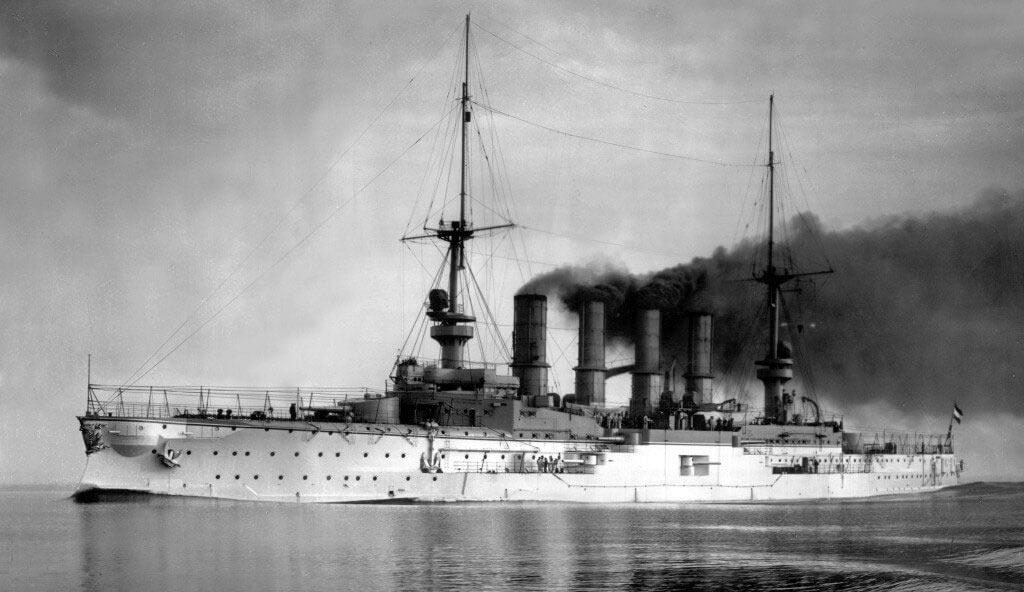
SMS Scharnhorst, the German flagship at the Battle of the Falkland Islands on 8th December 1914 in the First World War
SMS Gneisenau: Armoured (Heavy) Cruiser – completed in 1907 – 11,600 tons – main armament 8 X 8.2 inch and 6 X 6-inch guns – maximum speed 24.8 knots – crew: 38 officers and 726 non-commissioned ranks.

SMS Gneisenau, the second German armoured cruiser at the Battle of the Falkland Islands on 8th December 1914 in the First World War
From – https://www.britishbattles.com/first-world-war/battle-of-the-falkland-islands/

HMS Invincible, the British flagship at the Battle of the Falkland Islands on 8th December 1914.
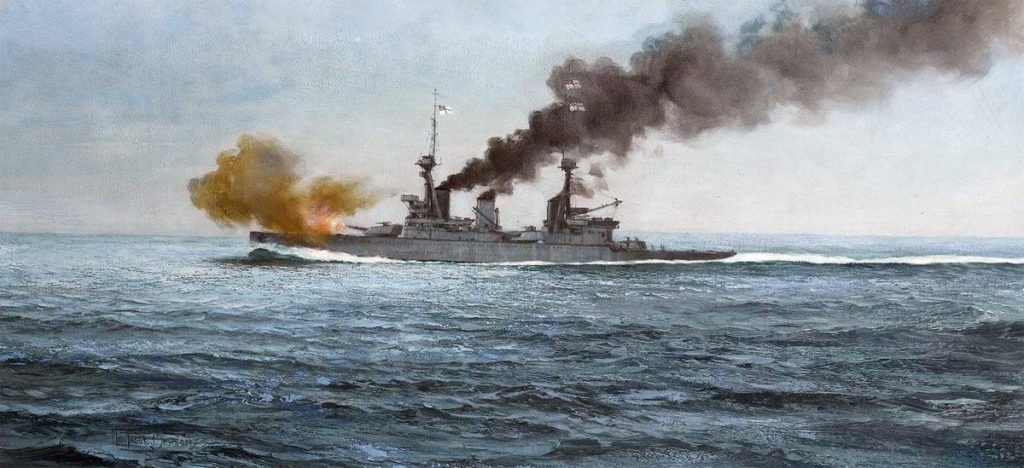
HMS Inflexible, the second British battle cruiser at the Battle of the Falkland Islands 8th December 1914 in the First World War: picture by Montague Dawson.
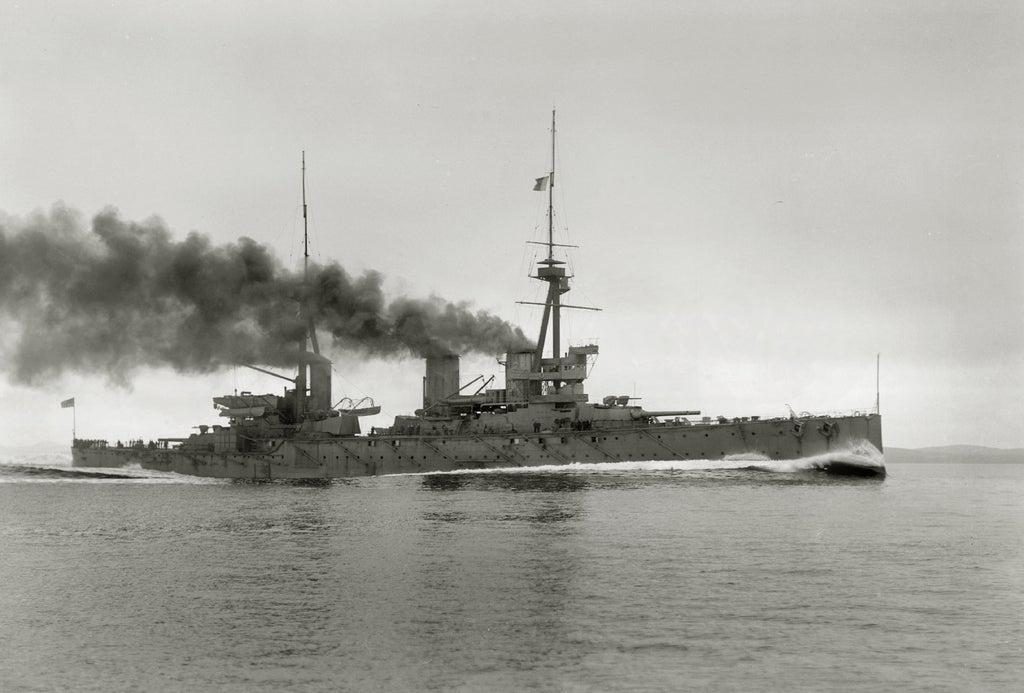
Invincible-class battlecruiser HMS Inflexible at speed.
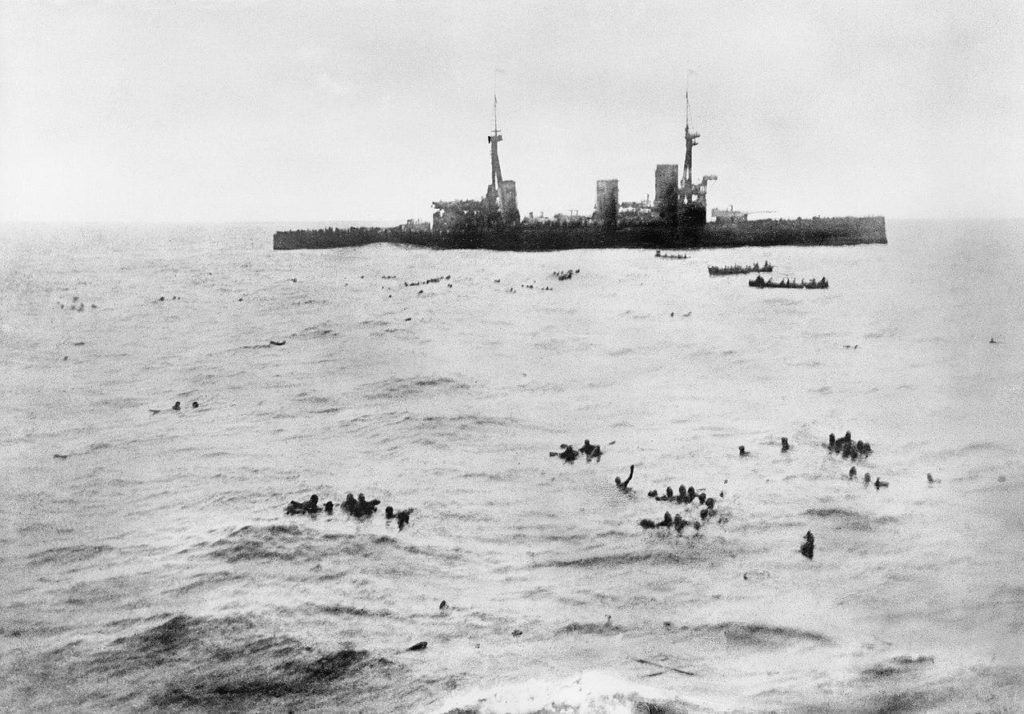
Paymaster Sub Lt Arthur Dyce Duckworth (on HMS Invincible) – This is photograph Q 20896 from the collections of the Imperial War Museums (collection no. [1]). The Royal Navy battlecruiser HMS Inflexible standing by to pick up survivors from the German cruiser SMS Gneisenau after the Battle of the Falkland Islands.
After being repaired and refitted at Gibraltar, she replaced Indefatigable as the flagship of the Mediterranean Fleet, arriving at the Dardanelles on 24th January 1915. Invincible was involved in the shelling of the Turkish Forts in February and March, to little effect. On 18th March they tried to suppress Turkish guns so that minesweepers could clear the minefields. She was hit a number of times by heavy Turkish fire from the forts. One of her main guns was knocked out, a shell hit below the waterline (only dinting the plate), another hit the yard above the foretop (killing or wounding everyone there) and one hit the foremast, destroying all the cables and voice pipes running through the foremast to the fire control director.
The Honour Sheet printed in M. 0407/15 (Sheets 7 8 & 9) has a listing for Arthur W Blaker, Lieutenant with seniority from 1.10.11 on Inflexible was recommended by Captain Phillimore with the nature of service being “Much credit is due to the skill which four years experience has given Lieutenant Blaker in working the rate, which he did for four long hours. (Since killed in action).” A list of naval war medals shows Lieutenant A W Blaker RN was mentioned in despatches (gazetted 2.5.19), but there is no entry in the column “if entitled Victory Medal” or to whom it was issued to. The last column has DD entered, but it is not known what that means.
He was on board HMS Inflexible when it was hit by Turkish gun fire on 18th March 1915 and he was wounded and died the following day. There were only six officers who died as a result of the 18th March 1915 action when the British and French fleet attempted to destroy the Turkish forts. Two of the officers (including Lieutenant Blaker) were on board HMS Inflexible and the other four were on board HMS Irresistible. He died on Hospital Ship Soudan at Tenedos Island on 19th March 1915 and was buried at sea. His death was recorded in Naval War Deaths 1914-1921, with index listing him as Lieutenant Arthur W Blaker on the ship Inflexible, with the year 1915 and volume RNO. on page 18.
In the Register of Deceased Passengers on the Soudan, official number 114052 and port of registry being Greenock, on 19th March 1917 on board in the harbour near Tenedos Island, Arthur W Blaker, aged 26, British and birthplace unknown, a Lieutenant in the Royal Navy, died of severe shell wounds. His last place of abode was HMS Inflexible. A Naval Officer casualty form was filled out, giving those details of his name, rank, branch of service, date and place of death and the cause. It was docket number A66.
The service record for Arthur W Blaker, date of birth 27th March 1889, shows he had seniority as a Sub-Lieutenant from 15th January 1909 and a Lieutenant from 1st October 1911. For Certificates of Passing, he had 2 in Seamanship, 3 in Part I (with part 2 crossed out), 2 in Pilotage, 2 in Gunnery and 2 in Torpedo. His list of appointments reads:
| Ship | Rank | Date of Appointment | Date of Discharge |
| Powerful | Mid | 15th Sept 05 | 4th Sept 07 |
| Hibernia | Mid | 4th Feby 1905(? 08) | 10th Sept 08 |
| Dominion | Mid | 11th Sept 08 | 11th Jany 09 |
| courses | ASL | 12th Jany 09 | Sept 09 |
| Diamond Aust tempy* | SL | 14th Sept 09 | 18 Oct 09 |
| Moy on recom | – | 19 Oct 09 | 11 Oct 10 |
| Inflexible | SL | 12 Oct 10 | 18/3/15 DD |
Under Inflexible, was also written, on recom. reappointed in lieu of Sub1.X.11; Inflexible p.c as Lt 24 Oct 11; & on recom. 5 Nov 12. * Not sure what is written?
In the remarks column are a series of entries: Active intelligent perseveres well. A very good young Officer zealous and painstaking, but unfortunately has been in hospital with a broken thigh. Captain Halery. Promises well. Captain Lambert. Watchkeeping Certificate Oct 10. S206 All VGI Zealous & capable. G judgement as O.O.W. & Executive Officer of small ship. Recd for promn. Lt Com Corlett Oct 10 S206 VGI. VG. VG. V. capable. Of high character. As S. Lt. in the Gun Room set an example strict in discipline & gentlemanly in tone. Great promise. Capt. Napier Nov 11. S206 VG1. VG1. VG. V. active & zealous v. reliable OOW Capt. Phillimore Nov 12. 8.12.14 Falkland Ids action – mentioned in report from Conning Offs of Inflexible “Much credit is due to the skill which four years experience has given Lt Blaker in working the rate which he did for four long hours.” S.206. Sct. Cw. A thoroughly sound practical officer, good at fire control and would make an excellent gunnery Lieut. of a small ship. Capt. Laxley Aug 1914.
The next lines read “Wounded in Action in Dardanelles (since dead)”, “Wounded 18 March 1915” and “Died 19 March 1915 at 8.30 am”.
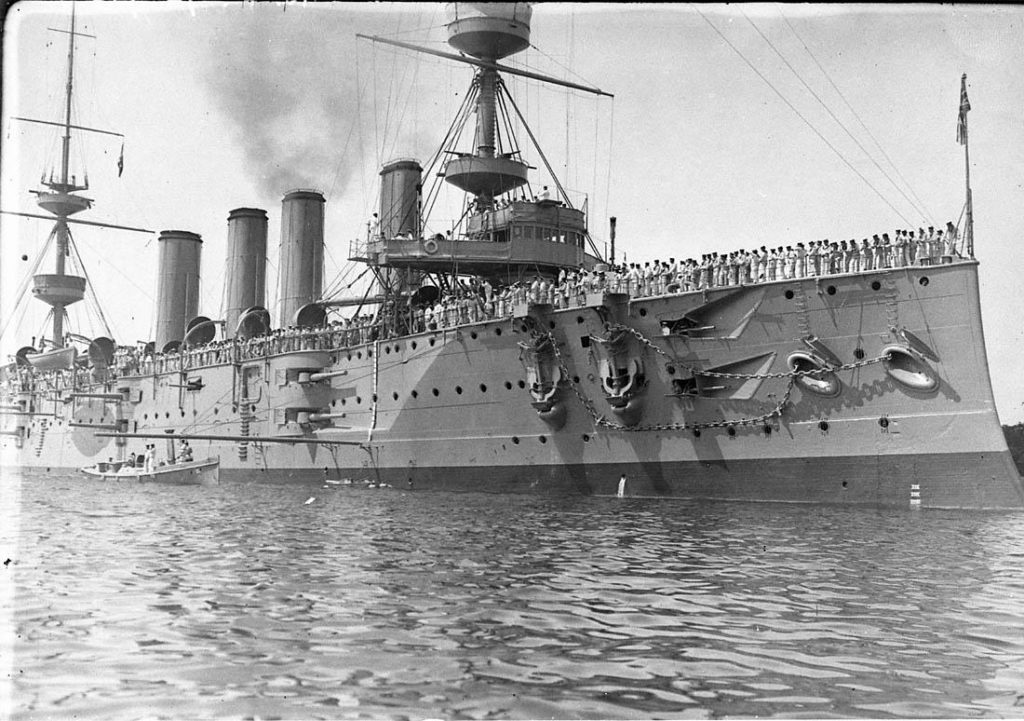
Sailors on deck of four-funnel cruiser HMS Powerful, Australian Squadron, Sydney Harbour.

HMS Hibernia By Symonds & Co – This is photograph Q 21344 from the collections of the Imperial War Museums (collection no. 2107-01), Public Domain, https://commons.wikimedia.org/w/index.php?curid=6994632

HMS Dominion By Symonds & Co – This is photograph Q 21170 from the collections of the Imperial War Museums (collection no. 2107-01), Public Domain, https://commons.wikimedia.org/w/index.php?curid=3237110

HMS Moy
Arthur is named in Panel 8 of the Chatham Naval Memorial. He is listed in CWGC in Index No. M.R. I of the Chatham Naval Memorial 1915 as “BLAKER, Lieut. Arthur Wilfrid. Mentioned in Despatches. R.N. H.M.S. “Inflexible”. Died of wounds, received in the attack on Dardanelles, 19th March, 1915. Age 26. Son of Arthur Beckett Blaker and Elizabeth J. Blaker, of The Lodge, Portslade, Sussex. 8.” St Nicolas’ Church South Street Portslade Village Hove Sussex has a WW1 memorial with A W Blaker as one of 89 on the list. The churchyard also has a plaque as a memorial to him, on the Blaker vault which is next to the church, near the tower (picture below) – http://portsladehistory.blogspot.com/2012/07/st-nicolas-churchyard-monumental.html . Numerous other Blaker’s are buried there, including his family members. His plaque reads – “BLAKER – Also of Lieutenant Arthur Wilfrid Blaker RN HMS Inflexible, elder son of Arthur Beckett and Elizabeth Jane Blaker, killed in action in the Dardanelles, March 18th 1915 aged 26 years. He was buried at sea.” His parents’ memorial reads as part of 87 “Also of Arthur Beckett, elder son of the above named John and Mary Blaker, died 25th August 1914, aged 71 years. Also of Elizabeth Jane, wife of the above named Arthur Beckett Blaker, died March 15th 1924 aged 69 years.” His siblings read in 89 “BLAKER – Also in memory of the daughters and younger son of Arthur Beckett and Elizabeth Jane Blaker; Dorothy Kathleen Hodgson 7th February 1888 – 16th December 1960. Brenda Mary Gordon Jones 12th March 1891 – 5th March 1962. Geoffrey Beckett Blaker 15th March 1893 – 2nd May 1963. Barbara Joan Graham 24th December 1894 – 30th May 1948.” He is listed in the memorial registers for Bedford School Altar and Reredos WW1 and St Nicolas Church WW1 Portslade Village East Sussex. He is listed in the “UK and Ireland, Obituary Index”.

Blaker memorials. (With thanks to the website above)
A newspaper article on him reads: –
LIEUTENANT ARTHUR WILFRID BLAKER, R.N., H.M.S. “INFLEXIBLE,” born at Beechwood, Lewes, on the 27th March 1889, was the elder son of Mr. and Mrs. Arthur Becket Blaker, of The Lodge, Old Portslade, Sussex. He was educated at Bedford Grammar School and at Eastman’s Naval Academy, passing into H.M.S. “Britannia” in 1904. In 1905 he became Cadet Captain, and on the completion of his training was appointed Midshipman to the “Powerful,” Flagship in the Australian Squadron, afterwards serving in battleships “Hibernia” (February 1908) and “Dominion” (September 1908). Mr Blaker was promoted acting Sub-Lieutenant in January, 1909, was subsequently confirmed in his rank, and served in the same year in the torpedo-boat destroyers “Wolf and “Moy” (October 1909). In October, 1910, he was appointed to the “Inflexible” and received his promotion to the rank of Lieutenant in 1911. In the following year he was re-appointed to H.M.S. “Inflexible,” and was serving in her when she was in action off the Falkland Islands on the 8th December, 1914, on which occasion he was specially mentioned in reports. The “Inflexible” sailed for the Mediterranean in the early part of 1915, and was in action in the Dardanelles on the 18th March, when Lieutenant Blaker was wounded by an enemy shell, and died from the effects the same night. He was buried at sea. The Captain of H.M.S. “Inflexible” wrote: “You will have heard long before this of the death of your gallant son, and others will have told you how bravely he bore the pain of his wounds. I first met him when I came to the “Inflexible” in 1911, and realised at once that he was an excellent officer. As time went on I was more and more impressed with his ability and seamanlike skill, and was sure that he would make his mark in the service thereafter… I had specially reported on the good work he did in the Falklands action, when he was doing the same duty as on March 1915, assisting to control the gunfire from aloft. This time, alas! I could only place on record the loss that His Majesty’s Navy had suffered by his death.” The Surgeon of the “Inflexible” wrote: “I had the sad duty of attending him immediately after the accident, and can testify to the fine spirit and the courage with which he bore himself… He was the best of mess-mates, invariably cheerful, and always ready to throw himself heart and soul into anything that was going on.” The Chaplain wrote: “His end was a very gallant one, and he met his death with the greatest fortitude. He was in the foretop controlling the fire of the guns when a shell burst and seriously wounded him. He died that night in the hospital ship… I never met an officer more universally beloved than your son, and I know that he was looked upon as an extremely able officer. He was the life of our mess, always cheerful and ready to help others.”
The article also included his portrait photo as above.
Probate was granted for “BLAKER Arthur Wilfrid of HMS Inflexible lieutenant R.N. died 19 March 1915 at the Dardanelles on active service Probate London 23 September to Robert Arthur Denby solicitor. Effects £2636 1s. 11d.”

ST NICOLAS CHURCH PORTSLADE ROLL OF HONOUR IN MEMORY OF THE MEN FROM THIS PARISH WHO FELL IN THE WAR 1914-1918 and 1939-1945
also
THE OLD BOYS OF THE PORTSLADE INDUSTRIAL SCHOOL 1914-1918

(All the listed names in St Nicolas Church, are also commemorated on the Portslade War Memorial in Easthill Park, Portslade)


A photo in the church – pictures from IWM. © Andrew Tatham (WMR-7655)
His mother donated the oak reredos at St. Nicholas Church, Portslade, in his memory.

Picture of church and memorial -with thanks to- http://www.roll-of-honour.com/Sussex/Portslade.html




From the book “Hove and Portslade in the Great War” by Judy Middleton is a picture of the reredos above and the following story: – “HMS Inflexible arrived at the Dardanelles on 24 January 1915 and some three weeks later she started to bombard Turkish forts, but without much success. A few weeks later she was busy firing her guns on 15 and 18 March trying to silence Turkish ordnance and give British minesweepers a better chance of success. But Inflexible struck a mine and was hit a number of times. On 18 March 1915, Lieutenant Arthur Wilfrid Blaker of HMS Inflexible was killed in action and buried at sea. He was born on 27 March 1889 and came from a notable Portslade family. He was the son of Arthur Beckett Blaker, who married his second cousin Elizabeth Jane. Her father was Edward Blaker of Easthill House, Portslade, and he was twice married, each wife producing six children. The young lieutenant’s mother had become a widow in 1914 and now had lost her eldest son. In his memory she donated the oak reredos in St Nicholas Church, Portslade, which is still in place to this day.”
With his family: –
His father, is recorded in the Oxford University Alumni as “Blaker, Arthur Beckett, 1s. John, of Lewes, Sussex, gent. WORCESTER COLL. Matric. 13 Oct., 1860, aged 17.” In the 1911 trade directory he was listed as a private resident in Portslade Lodge. Arthur passed away on 25th August 1914 in Steyning Sussex. He was buried in the family vault in Portslade, East Sussex, England. Probate went to his wife and Reginald Blaker (a solicitor) with effects of over £19000.
His mother had been born on 17th February 1855 in Portslade. Her parents were Edward Blaker (1821-1883) and Ellen Isaacson (1828-1856). She passed away on 15th March 1924 in Bath Somerset and was also buried in the family vault in St Nicolas Churchyard. Probate was granted to Geoffrey and Dorothy and a Harold Montagu Blaker of over £1076.
Geoffrey Beckett Blaker was born on 15th March 1893 and was on the roll at Bedford Kindergarten School. In WW1 He served in King Edward’s Horse as a Lieutenant and his service record is available at National Archives UK under WO 339/124328, but not online. Geoffrey joined them as Private 651 and was promoted to Acting Corporal. He entered France on 21st April 1915. On 22nd February 1918 he was commissioned as a 2nd Lieutenant. He applied for his medals on 3rd May 1922 and his 1914-15 Star, British War and Victory medals were sent out on 13th July 1922. His address was noted as in Colchester Essex. He held shares in the Great Western Railway in 1924 at Chelmsford. In 1927 he married Georgina Volta Bryant. A 1933 directory gave his address as Chase cottage in West Bergholt near Colchester. In the 1939 register he was still living there and was listed as a farmer. He was there with Georgina V Blaker doing unpaid domestic duties and Alice Wright (probably her mother), who was listed as incapacitated. It also noted his WW1 service. He passed away in his house on 2nd May 1963 and was buried in the family plot. Probate to his widow was granted in August for over £2700. Georgina passed away in 1981 and probate for her will gave a listing of effects of over £66000.
Dorothy Kathleen Blaker was born on 7th February 1888 in Lewes Sussex. She married Sydney Hodgson on 28th July 1914 in the Parish Church at Portslade. He was 12 years older than her. In the 1939 register, they were living at 35 Bird-in-Hand Lane in Bromley and he was recorded as being an Auctioneer of Libraries, Rare Books & Manuscripts. She died on 16th December 1960 in Bromley and was buried with the family. Sydney died in 1973.
Brenda Mary Blaker was born on 12th March 1891 in Lewes. She married Cyril Gordon Jones on 24th September 1914 at Chapel en le Frith, Derbyshire. He was 7 years older. Cyril served in the air force as an officer from 1918 to 1919, but his record is not able to be viewed. In the 1939 register, they were living at Shrublands, Lexden and Winstree, Essex and he was a Solicitor. Brenda passed away on 5th March 1962 and is buried in the family grave. Cyril died in 1964.
Barbara Joan Blaker was born on 24th December 1894 at East Liss Hampshire. She married Harry Woodthorpe Graham in Johannesburg South Africa on 1st June 1921. In March 1934 they moved back to England with two daughters. Harry was a mining engineer. In the 1939 register they were living at Friars Field, Stroud, Gloucestershire. He was a retired mining engineer and she was living on private means. Harry died in 1942 in Colchester. Effects of over £5200 went to Barbara. She died on 30th May 1948 in Northern Ireland and was buried in the family plot.
Arthur’s medals; the 1914-15 Star, British War medal and Victory medal with oak leaf, were issued to his brother with I.C. Number 36/533 from the navy roll.

ANZAC Biographies
On our website you will find the biographical details of ANZAC (as well as British) servicemen & women whose medals or other memorabilia form part of the collection on display at the Maryborough Military & Colonial Museum, Maryborough, Queensland, Australia.
Array